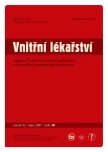Endoscopic changes in the stomach and duodenal mucosa caused by minidose acetylsalicylic acid therapy and their prevention
Authors:
I. Novotný; Petr Dítě
; M. Kunovská; H. Münzová
Authors‘ workplace:
Interní gastroenterologická klinika Lékařské fakulty MU a FN Brno, pracoviště Bohunice, přednosta prof. MUDr. Petr Dítě, DrSc.
Published in:
Vnitř Lék 2007; 53(10): 1053-1056
Category:
Original Contributions
Overview
Minidose acetylsalicylic acid (ASA) administration is a significant risk factor for changes in the stomach and duodenal mucosa also in persons whose anamnesis does not indicate any previous symptoms of stomach disease or any other risk factor. One month ASA minidose therapy provoked changes in the stomach and duodenal mucosa in 43.7 % of persons receiving the therapy for cardiologic or neurologic indications. The changes primarily involved erosion and were mainly located on the stomach mucosa, without signs of active bleeding. If ASA minidose therapy was administered for 1 month together with the proton pump inhibitor omeprazole, the rate of incidence of changes detected in the mucosa was statistically significantly lower, i.e. only 27.6 %, again without signs of fresh bleeding. The presence of Heliobacter pylori probably does not play a critical role; Heliobacter pylori was only detected in 34.1 % of patients with changes in the mucosa. The persons who need ASA minidose therapy and especially those with risk factors must be secured by drugs with protective effect on the stomach and duodenal mucosa during ASA therapy, specifically in the form of proton pump inhibitors. Considering the benefit and complications of low-dose ASA therapy, it should not be indicated to persons with a low risk of cardiovascular or cerebrovascular complications and should be reserved for the treatment of high risk patients.
Keywords:
acetylsalicylic acid – mucosa erosion – omeprazole
Sources
1. Aspirin Myocarcial Infarction Study Research Group: A randomized, controlled trial of aspirin in patients recovered from myocardial infarction. JAMA 1980; 243: 661-669.
2. Harrington RA, Becker RC, Ezekowitz M et al. Anthithrombotic Therapy for Coronary Heart Disease - The Seventh ACCP Conference on Antithrombotic and Thrombolytic Therapy. Chest 2004; 126: 513S-548S.
3. Lanas A, Bajador E, Serrano P et al. Nitrovasodilators, low dose aspirin, other nonsteroidal anti-inflammatory drugs, and the risk of upper gastrointestinal bleeding. N Engl J Med 2000; 348: 834-839.
4. Kelly JP, Kaufman DW, Jurgelon JM et al. Risk of aspirin associated major upper-gastrointestinal bleeding with enteric-coated or buffered product. Lancet 1996; 348: 1413-1416.
5. Cryer B, Luk G, Feldman M. Effects of very low doses of aspirin on gastric, duodenal and rectal prostaglandins and mucosal injury. Gastroenterology 1995; 108: A77.
6. Cryer B. Nonsteroidal anti-inflammatory drug injury. In: Feldman M (ed). Sleisenger & Fordtran’s, Gastrointestinal and Liver Disease. 7th ed. Philadelphia: WB Saunders 2002: 408-430.
7. Feldman M, Shewmake K, Cryer B. Time course inhibition of gastric and platelet COX activity by acetylsalicylic acid in humans. Am J Physiol Gastrointest Liver Physiol 2000; 279: G1113-G1120.
8. Niv Y, Battler A, Abuksis G et al. Endoscopy in asymptomatic minidose aspirin consumers. Dig Dis Sci 2005; 50: 78-80.
9. Singh G, Triadafilopoulos G. Epidemiology of NSAID-induced GI complications. J Rheumatol Suppl 1999; 56: 18-24.
10. Lanas A, Garcia-Rodriguez LA, Arroyo MT et al. NSAIDs, aspirin, PPIs and the risks of upper GI bleeding in common clinical practice. Gastroenterology 2005; 128(Suppl 2): A95.
11. Rodrigues LAG, Jick H. Risk of upper gastrointestinal bleeding and perforation associated with individual nonsteroidal antiinflammatory drugs. Lancet 1994; 343: 769-772.
12. Gabriel SE, Jaakkimainen L, Bombardier C. Risk for serious gastrointestinal complications related to use of nonsteroidal antiinflammatory drugs. Ann Intern Med 1991; 115: 787-796.
13. Derry S, Kong Loke Y. Risk of gastrointestinal haemorrhage with long term use of aspirin: metaanalysis. BMJ 2000; 321: 1183-1187.
14. Kelly JP, Kaufman DW, Jurgelon JM et al. Risk as aspirin-associated major upper-gastrointestinal bleeding eith anteric-coated or buffered product. Lancet 1996; 348: 1413-1416.
15. Stack WA, Atherton JC, Hawkey GM et al. Interaction between Helicobacter pylori and other risk factors for peptic ulcer bleeding. Aliment Pharmacol Ther 2002; 16: 497-506.
16. Lanas A, Fuentes J, Benizo R et al. Helicobacter pylori increases the risk of upper gastrointestinal bleeding in patients taking low-dose aspirin. Aliment Pharmacol Ther 2002; 16: 779-786.
17. Chan FKL, Sung JJY, Chung SSC et al. Randomised trial of eradication of Helicobacter pylori before non-steroidal anti-inflammatory drug therapy to prevent peptic ulcers. Lancet 1997; 350: 975-979.
18. Venerito M, Treiber G, Wex T et al. Effects of low-dose aspirin on gastroic mucosal prostaglandin - E2 do not depend on Helicobacter pylori infection. Aliment Pharmacol Ther 2006; 23: 1225-1233.
19. Lahij RFJ, Van Rossum LGM, Jansen JBMJ et al. Proton-pump inhibitor therapy for acetysalicylic acid associated upper gastrointestinal symptoms: a randomized placebo-controlled trial. Aliment Pharmacol Ther 2003; 18: 109-115.
20. Chuen Lai K, Lam Kum S, Man Chu K et al. Lansoprazole for the prevention of recurrences of ulcer complications from long-term low-dose aspirin use. N Engl J Med 2002; 346: 2033-2038.
21. Yeomans ND, Lanas A, Talley NJ et al. Prevention of low dose aspirin-associated gastroduodenal ulcers and upper gastrointestinal symptoms in patients receivin esomeprazole 20 mg per day. Gastroenterology 2006; 130(Suppl 4): A81 (abstrakt 561).
Labels
Diabetology Endocrinology Internal medicineArticle was published in
Internal Medicine

2007 Issue 10
Most read in this issue
- Cortisol levels are more closely associated with depressiveness and other psychopathologies than catecholamine levels
- Pseudomembranous colitis
- Pulmonary alveolar proteinosis
- Our experience in continuous administration of insulin using infusion dispenser at a metabolic intensive care unit (MICU)
